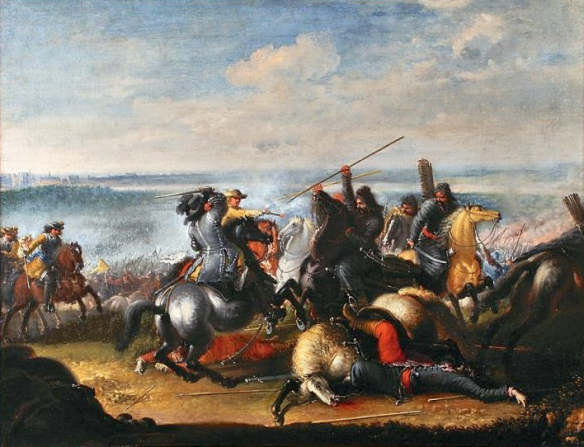Swedish King Charles X Gustav in skirmish with Polish Tatars near Warsaw 1656.
Siege of Warsaw (1656) second day.
By the numbers involved, this was a colossal, three-day fight during the second campaign of the Second Northern War (1655-1660). Measured by casualties, it was a much smaller affair: Polish losses were about 1,000 cavalry and 600 infantry, while the Allies lost about 700 killed and wounded, though these numbers are often greatly swollen in various nationalist retellings of the battle.
The Polish Army under John II Casimir numbered 25,000 regulars, from 10,000-13,000 noble levies, and 2,000 Tatar allies. Of these troops, barely 4,500 were infantry. Many of the peasants who rallied to Casimir were half trained at best, while his noble levies were as they always had been: ill-disciplined and haughty. The Poles were also under-gunned. Nevertheless, Casimir ferried some troops across the Vistula to attack along the right bank of the river, while others were ordered to advance against the Swedes along the left bank. Karl X commanded an allied force of 18,000 men, about equally divided between Swedes and Brandenburgers. These troops were well-trained and well-armed professionals, and they had far more big guns. Interestingly, this army also was predominantly cavalry and dragoons: some 12,000 horse soldiers were divided into 60 squadrons, supported by only 5,500 infantry divided among 15 brigades.
On the first day, Karl took the offensive by attacking Polish infantry entrenched along a narrow neck of land on the right bank. The attack failed to dislodge the Poles. On the 29th, he used cavalry to screen a risky maneuver by his own infantry, which he wheeled left through wooded terrain. He was established in a new position before the Poles could attack, but they did anyway, sending in 800 hussars while the weaker but more numerous Pancerna cavalry held back. The charge was brave but unsuccessful, as Karl deployed his Swedish- Brandenburg horse in three lines. The hussars broke through the first two Allied lines, but were counter charged by the third. Casimir withdrew his forces, admitting defeat and abandoning Warsaw for the second time in 12 months. The Allies entered Warsaw the next day. The Battle of Warsaw was notable for a Swedish emphasis on deploying cavalry when fighting in Poland, something the Swedes had learned from earlier defeats at Polish hands. But it was not close to being a decisive battle and did not determine the outcome of the war.
Karl X of Sweden (1622-1660).
King of Sweden, 1654-1660. He trained for war under the great Swedish artillery master Lennart Torstensson (1603-1651) and saw action at several battles of the Thirty Years’ War (1618-1648), ending as commandant of all Swedish forces in Germany. Worried about the Russian invasion of Poland-Lithuania that began the Thirteen Years’ War (1654-1667), he tried to conquer large, new territory in Poland during the “Little” or Second Northern War (1655-1660), in a serious overreach of Swedish power. He captured Warsaw in 1655 but could not overcome Polish defense of the fortress-monastery of Czestochowa from 1655-1656. The next year he campaigned against Denmark, performing several virtuoso field maneuvers that brought him to the suburbs of Copenhagen. His success in the field forced Denmark to cede large swaths of territory to Sweden in the Treaty of Roskilde (February 26/March 8, 1658). But he fundamentally failed to improve Sweden’s geostrategic position in the Baltic. He startled all Europe by sailing away from Kiel only to turn around and attack Copenhagen a second time, in an effort to repress Denmark permanently and establish Sweden as the dominant Baltic and Scandinavian power. His attempt to exclude all foreign fleets from the Baltic provoked Dutch intervention, which forced him away from Denmark.
He died unexpectedly on February 23, 1660, opening the door to a negotiated settlement with Denmark and its allies, and an end to the Second Northern War. His death at age 37 also left a four-year-old son, Karl XI, on the throne.
